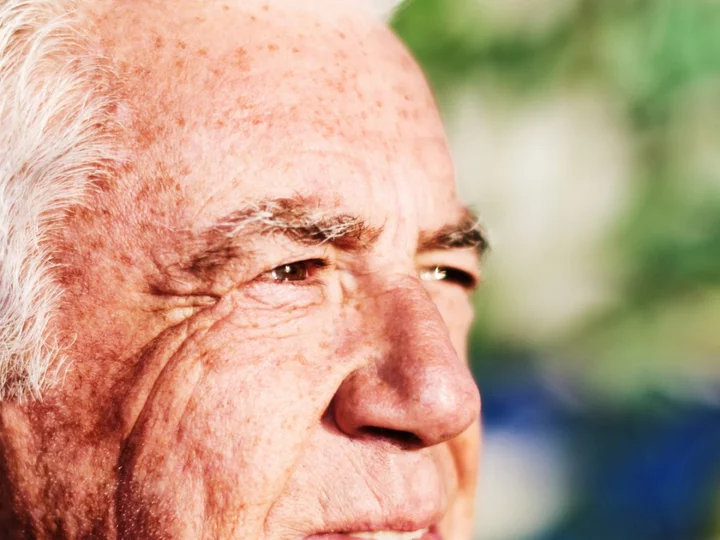
What is fezolinetant? The non-hormonal menopause treatment drug explained
The menopause treatment fezolinetant has been predicted as a “gamechanger” by experts for thousands of women who suffer from hot flushes. The drug, which is the first non-hormonal menopause treatment, was recently approved by America’s FDA. Experts are predicting it could be transformative for women for whom hormone replacement drugs (HRT) are not suitable. The drug was licensed in the US on 12 May and could be approved for use in the UK by the end of the year. According to a British Menopause Society survey, 79 per cent of women aged 45 to 65 experienced hot flushes as a result of their menopause transition, while 10 to 20 per cent describe the hot flushes as “near intolerable”. Here’s everything you need to know about fezolinetant: What is it used to treat? It works to target the menopause symptom of hot flushes. The drug that has been approved by the FDA is made by pharmaceutical company Astella, which advises patients to take one 45-milligram of its VEZOAH (fezolinetant) pill orally, once a day. A large clinical trial of fezolinetant published earlier this year revealed that, after 12 weeks of use, it reduced the frequency of hot flushes by about 60 per cent in women with moderate or severe symptoms, in comparison to a 45 per cent reduction in those who received a placebo. Women involved in the trial also said the drug reduced the severity of hot flushes and improved the quality of their sleep. How does it work? It works by blocking a brain protein called neurokinin-3, which plays a unique role in regulating body temperature in menopausal women. Respondents of the trial have said that the effects of the drug was experienced after taking the first tablet. By comparison, HRT, taken to alleviate menopausal symptoms, replaces the oestrogen that you lose during the menopause transition, either alone or in combination with a progestogen What are the side effects? According to the FDA, the most common side effects are abdominal pain, diarrhoea, insomnia, back pain, hot flush and elevated hepatic transaminases. What have experts said about it? “This is going to be a completely blockbuster drug,” said Prof Waljit Dhillo, an endocrinologist at Imperial College London who led a trial for the drug in 2017 toldThe Guardian. “It’s like a switch. Within a day or two the flushes go away. It’s unbelievable how well these drugs work. It’s going to be completely game changing for a lot of women.” Read More Adenomyosis: 5 things you need to know about the ‘evil twin sister’ of endometriosis ‘Suddenly, I saw Dad again’: The radical technology helping those living with dementia Naga Munchetty reveals womb condition adenomyosis: ‘I live every day on painkillers’
2023-05-22 21:29

13 Old-Timey Synonyms for ‘Hot’ to Bring Back This Summer
Why be sweltering and sunburnt when you can be swoly and birsled instead?
2023-05-22 20:17

Adenomyosis: 5 things you need to know about the ‘evil twin sister’ of endometriosis
Despite increasing public awareness of endometriosis, with celebrity figureheads including Lena Dunham and Molly Mae, the condition’s ‘evil twin sister’, adenomyosis, remains neglected. While the NHS has an entire webpage which explains what endometriosis is, there is currently no equivalent for its sister condition. Read on for five things you should know. It’s not the same as endometriosis Both endometriosis and adenomyosis occur when the lining of the uterus (known as the endometrium) grows out of place, but there are major differences between the two. In endometriosis, the rogue tissue invades areas outside of the uterus. While the extent of the growth varies from patient to patient, it can affect areas such as the bladder, bowel, ovaries, and even the lungs. Adenomyosis, on the other hand, causes the rogue tissue to bury inside the muscular wall of the uterus. It’s possible to suffer from both conditions at the same time. Symptoms include bloating, heavy periods, and pelvic pain Thanks to the invasive endometrial growth, adenomyosis is characterised by an enlarged uterus. During menstruation, the embedded tissue swells and bleeds, typically causing a variety of symptoms (although some women are asymptomatic). According to a patient leaflet published by University College Hospital, sufferers commonly have painful and irregular periods, with more than half experiencing heavy bleeding. Chronic pre-menstrual pain, and feelings of heaviness and discomfort in the pelvis are among other possible symptoms. Less frequently, adenomyosis can cause bloating, pain during intercourse, and pain related to bowel movements. All symptoms should stop after the menopause. It affects 1 in 10 women The condition is believed to affect 10 per cent of women in the UK. That makes it just as prevalent as endometriosis, although it’s more common in women between the ages of 40-50, and those who have been pregnant before. While the cause of the condition is not known, UCH says that “genetics and some hormones may play a role”. In terms of long-term effects, the North Bristol NHS trust says that adenomyosis does not appear to decrease the chance of pregnancy, however it has been linked to an increased risk of miscarriage and premature birth. Treatment options are limited For women with mild symptoms, trying to get pregnant, or nearing menopause, the North Bristol trust says that treatment may not be necessary, but for those seeking relief from symptoms, it recommends medication to reduce pain and bleeding, and hormonal interventions such as the contraceptive pill. The only “cure” is a surgical procedure involving the removal of the womb (hysterectomy), although this is a last resort intervention. The Bristol-based trust also offers an alternative surgery which involves blocking the blood supply to the endometrial growth, forcing it to shrink, but neither procedure is advisable for women who want to get pregnant in the future. It can take years to diagnose The condition is typically diagnosed using MRI and ultrasound scans, but the NHS says that adenomyosis can take “a long time, even years, to diagnose” because “symptoms and severity can vary between women”. The frequent dismissal of women’s gynaecological symptoms means that signs of adenomyosis may be conflated with ‘normal’ menstruation, or even other conditions such as endometriosis. Anecdotal reports of sufferers suggest that misdiagnosis is common. Gabrielle Union, one of the only celebrities to have publicly identified as having the condition, suspects her condition went undiagnosed for years. Speaking at a conference in 2019, Union explained: “The gag is I had [adenomyosis] in my early twenties, and instead of someone diagnosing me they were like ‘Oh you have periods that last nine or 10 days and you’re bleeding through overnight pads? Not a mere inconvenience... perhaps there’s something more there.’” Earlier this year, the charity Tommy’s reported that the condition might be “underdiagnosed” after a review of existing studies found that “mild” cases could be missed by clinicians using current diagnostic methods. “There should be training for clinicians and sonographers to diagnose adenomyosis using a standardised criteria,” said Dr Ishita Mishra, leader of the review. “Being able to identify this condition using a uniform set of criteria would then help give us a true picture of the numbers affected, and better understanding of the impact of this condition,” Mishra explained. If you have any health concerns, you should always contact your GP in the first instance. There is also information available via NHS Scotland or Endometriosis UK. Read More Lena Dunham marks five years of sobriety: ‘Happiest of my time on earth’ ‘Some days things just do not work’: What happens when your smear test doesn’t go smoothly? Woman’s warning after terminal cancer mistaken for heavy periods 5 things you need to know about adenomyosis, the ‘evil twin sister’ of endometriosis Woman’s warning after lip filler left her unable to close mouth ‘Suddenly, I saw Dad again’: The radical tech helping those living with dementia
2023-05-22 19:45

Bella Poarch: Top 5 iconic outfits in 'Build a B*tch' singer's style file
Beyond her singing skills and amazing content, Bella Poarch has also been a style inspiration for many
2023-05-22 19:25

Woman’s warning after lip filler left her unable to close mouth
A woman horrified after lip filler left her unable to close her mouth has urged others to “do their research” before getting cosmetic surgery. Harriet Green, 23, wanted plumper lips after being influenced by videos on TikTok and influencers from Love Island, and went to a salon to get 1.1ml of filler in December 2022. Immediately after the procedure, which entailed a substance being injected into her face, Harriet’s lips started to swell up and bruise but she claims she was assured it was normal and they would go down within weeks. But three months later, her lips were still swollen and Harriet claims she was left with two painful lumps in her lips and unable to properly close her mouth. Harriet had to undergo three corrective procedures, costing £700 in total, to get her lips back to normal. Harriet, a council worker, from Acle, Norfolk, said: “This was the first time I had anything done. “On the way to my appointment, the woman at the salon told me to numb my own lips which now I realise you should not do. “When I was getting my lips done, it was painful but at that time I didn’t realise it is only painful when not done correctly. “Straight after they were very sore and started to bruise. “After all the bruising had gone, I had two hard lumps on my lip - one on the left and one on the right. “It made me feel so much more self-conscious - it was painful and uncomfortable.” Harriet got her lips done in December 2022 and paid £100 for 1.1ml of filler. After the procedure, Harriet thanked the aesthetics practitioner and headed home but started experiencing swelling and bruising on her lips - which she originally thought was standard. Harriet said: “I was assured that the bruising was normal, and it would go down. “But, after all the swelling and bruising had gone, I was left with two hard lumps. “I stopped going to the woman as I was annoyed, and people close to me started commenting on how my lips didn’t look good. “They said they could see unevenness in my lips and could see two lumps on the top tip. “I’d wake up in the mornings and my lips would be swollen.” Harriet found Dr Raja - a GP who runs her own aesthetics clinic in Norwich and underwent three corrective procedures - used to tissue to dissolve any hyaluronic acid-based filler - costing £700. Harriet said: “I had to get my lips dissolved three times as too much filler was put in and it was injected into the wrong place. “I had to go back three times before she could add new filler to my lips. “I have been lucky, don’t get me wrong, I still have lumps in my mouth, but people have had it a lot worse. “After getting my lips done it made me feel so much more self-conscious, it is painful and uncomfortable. “But now you can’t even tell I have had them done as I have had them done properly.” Originally, Harriet was injected with 1.1 mil and Dr Raja inserted 0.6 mil into her lips the second time around. Harriet said the world of cosmetic surgery is a “minefield” and it has put her off any cosmetic procedure for life. She said: “It is so common nowadays. “I don’t judge people - when you have never had anything done before, you don’t know what you should be looking out for. “Looking for what should go wrong and what should go right. “It is important to research the person, don’t just go off social media pictures like I did. “Look for healed pictures of someone’s lips, not just fresh off the needle as they will look nice and plump straight after.” Harriet believes that social media and reality shows like Love Island play a major role in people wanting to get cosmetic procedures. She said: “I won’t have anything done to my face now, at one point my TikTok was full of jaw filler and Botox which swayed me into wanting to get it done. “It seems like such a normal thing to do now - that is the problem. “Shows like Love Island, all the girls on there have had something done to enhance their look which is not natural. “You don’t really ever see anyone there who is ‘natural’ and not had something done. “It feels more common and appealing to others that if you have filler and botox you are seen as more attractive.” Read More Woman defends picking up ‘$8k’ sofa from New York street Couple with 37-year age gap who met when he was 15 have hopes dashed Eamonn Holmes makes startling claim about Phillip Schofield’s ‘nonsense’ This Morning statement
2023-05-22 18:56

Dixie D'Amelio: TikTok star's 5 best style moments
Dixie D'Amelio is well-known for making a statement with her fashion choices or her social media videos
2023-05-22 18:27

Fast and Furious franchise 'is in the pruning process'
Michelle Rodriguez feels excited about the future of the 'Fast and Furious' franchise.
2023-05-22 15:23

'She was robbed': Internet declares We Ani should have won 'American Idol' Season 21
Iam Tongi won 'American Idol' Season 21 but fans think We Ani deserved the coveted title
2023-05-22 14:29

‘Suddenly, I saw Dad again’: The radical technology helping those living with dementia
There is a scene in the 2020 film The Father, starring Anthony Hopkins and Olivia Colman, that is all too familiar for people caring for someone with dementia. In it, Hopkins’ character Anthony struggles to keep up with his daughter Anne’s (Colman) movements. One moment, she is bringing home dinner. The next, she is talking about moving to Paris with a boyfriend he doesn’t like. She’s in his flat. Suddenly, he’s in her flat. Her face shifts – she looks like someone he used to know, then a total stranger. Where is he? When is he? Dementia is a cruel sickness that radiates outwards, seeping into the lives of anyone in its orbit. Patients become lost in a maze of memories. The present day becomes too slippery to hold on to, so many retreat into themselves. Wayfinding – meaning the ability to find one’s way in the world – becomes severely impaired, resulting in anxiety, confusion, and distress that can be very difficult for families and carers to cope with. There is no cure for dementia, and most medical research is focused on finding treatments for diseases that cause dementia, such as Alzheimer’s disease and dementia with Lewy bodies. It’s extremely important work, but there’s also a need for tools that can help those living with dementia as well as their families and carers. As research shows that visual cues can help deliver much-needed aid and relief, a number of small creative companies are stepping in to fill in the gap. Sarah Harrison is the founder of Recognii, the world’s first entertainment DVD made especially for people with moderate to later-stage dementia. The idea for Recognii came about after Harrison began taking care of her father when he was diagnosed with Alzheimer’s in 2015. She and her mother, a former nurse, opted to care for him in their family home in Harrogate, where Sarah also resides. “As the condition progressed, he became very withdrawn,” she recalls. “He couldn’t watch TV or engage himself in his own activities, couldn’t really have a conversation, couldn’t read books anymore because he couldn’t follow the plot.” But amid all the gloom cast by the disease, there’d be breakthrough moments when Sarah saw her father as she always knew him. These moments often came when he watched children’s TV, as the faces of smiling, happy children and brightly coloured graphics grabbed his attention. “It was great, but it was also too childish and didn’t reflect his life,” Sarah says. “I thought, surely there must be something out there that is more simplistic viewing that does reflect adult experiences – but there was absolutely nothing.” An idea began to form. Sarah thought that if she could create engaging short clips of “gentle, joyful stuff” with no storylines, it would bring him some relief from the fog in his mind. “He responded to very bright colours and contrasts, and two-dimensional images, which reflected what we know about the way dementia impacts cognitive and visual processing.” Changes in visual perception occur when the sensory journey between the brain and organs (such as the eyes and ears) gets interrupted, or slows down due to dementia. According to Alzheimer’s UK, the disease can also lead to damage to the eyes or parts of the brain, which can then lead to misperceptions, misidentifications, hallucinations, delusions and time-shifting. Like Anthony’s experience in The Father, time becomes an amorphous thing, which jumps back and forth instead of moving in a linear fashion. As such, older memories can become safer places for dementia patients to revisit. I noticed the iPad gathering dust. She said it wasn’t easy for her to use and she missed getting letters and postcards like she did in the past Famileo, a company that creates “family newspapers” for elderly people – many with dementia – works with families of patients to create personalised hard-copy newspapers that utilise “reminiscence therapy” to help soothe and comfort. “Typically, people with dementia are more likely to remember long-term memories,” explains Tanguy De Gelis, a co-founder of the company. “Famileo includes old photographs of themselves and the family, which stimulates their memory and helps them remember people as they were.” Each photograph included in the newspapers is accompanied by text that helps provide context, so that the reader can easily identify who they’re looking at, as well as their own place in the family in relation to the people in the picture. “Managers and activity coordinators at care homes often tell us that a person’s dementia journey is not linear, that symptoms come and go,” De Gelis continues. “The consistency and reliability of these personalised newspapers allows it to be appreciated even more on the ‘good days’ patients have. It can be very hard for family members to think of things to talk about with an older relative, but the newspaper can be a conversation starter and provide a visual guide for both sides.” Having a physical newspaper is also a boon for many elderly people who struggle with smartphones, tablets and laptops. For De Gelis, it was his grandmother who inspired the idea for Famileo. “I bought my grandma an iPad as a Christmas present so she could keep in touch with the family through our WhatsApp group,” he recalls. “But one day I went to visit her and I noticed the iPad gathering dust. She said it wasn’t easy for her to use and she missed getting letters and postcards like she did in the past.” The slow pace in developing tools for coping with dementia is down to a lack of understanding about the disease, says Dr Emilia Molimpakis, CEO and co-founder of Thymia. For years, patients languished in care homes, their minds deteriorating as families watched on helplessly. “Unfortunately, up until recently, pinpointing clear signs of Alzheimer’s disease relied on invasive and/or expensive medical tests and these often don’t show clear results until the disease has progressed substantially.” But recent developments in medical treatments and in the field of artificial intelligence (AI) have shifted things. Dr Molimpakis’ platform involves building AI-powered tools to improve the speed, accuracy and objectivity of dementia diagnoses. Thymia also uses video game-style activities to test for symptoms of cognitive disorders, she says, such as major depression, anxiety and dementia. “Each game is built around one or more cognitive tests, the results of which show tell-tale signs of symptoms, such as fatigue issues, memory impairment, concentration difficulties and more,” she explains. It does so by using software that analyses “biomarkers” of disease while players complete the activities across three key data streams: voice, video and behavioural measures. By analysing how someone speaks or what facial micro-expressions they make, Thymia’s work-in-progress models have identified symptoms in major depressive disorders with more than 90 per cent accuracy, Dr Molimpakis says. Major improvements in healthcare mean that people are living longer – but in a cruel twist of fate, this means that dementia is becoming ever more prevalent. There are currently more than 55 million people living with dementia globally, and according to Alzheimer’s Disease International, this figure is expected to balloon to 78 million in 2030 and 139 million in 2050. While scientists are working on earlier diagnosis and treatment, the need for coping mechanisms for living with the disease is growing. Harrison remembers how her father would react when she showed him the clips she created. He passed away before the final version of Recognii’s DVD could be launched. “It’s like the clouds would part, just for a few seconds,” she recalls. “Suddenly, I saw Dad again. The moments when you get a glimpse of who they used to be are so precious, because as the disease progresses, you do feel like you are losing them. So having made something that helps bring them back, even temporarily – it’s like a gift.” Read More A One Direction fan claimed she had a brain tumour. Five years after her death, we still need answers ‘Death acceptance brings peace’: Are death doulas the cure for our fear of the end? ‘You always feel like you’ve done something wrong’: Why UK surrogacy laws need a ‘real overhaul’ Jason Manford comforted by fans after announcing death of family member Grandmother praised for refusing to babysit daughter’s newborn for free 7 tips and tricks for hay fever relief
2023-05-22 14:22

AP PHOTOS: Guatemala-born designer links history and culture with current trends in fashion show
BROWNSVILLE, Texas (AP) —
2023-05-22 12:28

How wildfires in Alberta lead to poor air quality in the Midwest
Residents of the central United States experienced poor air quality and smoke over the weekend. The potentially dangerous air has a far-off source: the wildfires raging in Canada.
2023-05-22 03:51

Nashville resident couldn't get tickets to Taylor Swift's Eras Tour, so he got a job as a security guard and attended anyway
Nashville accountant Davis Perrigo wasn't able to secure tickets to Taylor Swift's concert the old-fashioned way, so he devised a creative plan to attend anyway.
2023-05-22 02:24
